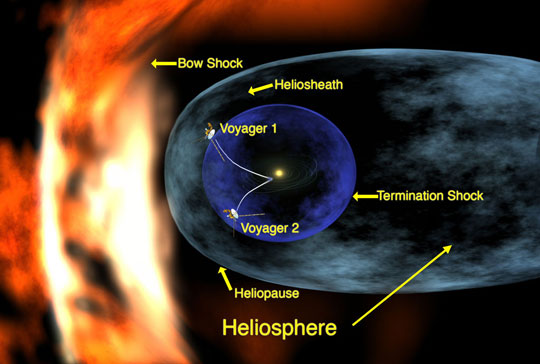People are about to leave the Solar System
After a 33-year journey, the Voyager 1 carried the message of human civilization that surpassed 17.7 billion kilometers, approaching the edge of the solar system.
In a NASA route announced on December 13, within the next four years, Voyager 1 will be out of the Solar System.

Voyager 1 unmanned explorer ship has reached the edge of the Solar System. (Photo: Daily Mail).
NASA said that in the current position of Voyager 1 , the average speed of these charged particles is almost zero. This also means that this explorer ship has approached the outer edge of the Facet God.
'That means that the heliopause is no longer far from Voyager. Voyager 1 is entering the interplanetary space , "said Ed Stone, a scientist with Voyager ship development.
Since 2004, this unmanned exploration ship has entered a region of space where the rate of charged particles brought by solar winds drops to only 1 million miles per hour. It is the solar wind area that comes into contact with matter in the interstellar space.
In June, when charged particles hit the Voyager 1 outer shell at speeds similar to the speed of the ship, the scientists concluded that the speed of the solar wind is now zero. A re-examination of the device used to measure the speed of charged particles around the ship to ensure that no negligence occurred.
Rob Decker, who was in charge of charge-carrying speed measuring devices around the ship, said: ' When we were certain that the speed was zero, I felt incredibly surprised. It also proves that, after 33 years of journey, Voyager will bring us new discoveries . '
NASA also said that in 2014, after crossing this boundary, the number of high-temperature carriers in the current position of the ship will drop rapidly. Instead, low-temperature charged particles in the interstellar space.
Specific information about this event was reported at the 2010 Earth Physics Conference held in San Francisco.
Voyager 1 was launched into space on September 5, 1977. Voyager 1 was originally designed to explore Jupiter and Saturn, but it continues its journey into the universe to this day.

Voyager 1 became the farthest artificial device in the universe. (Photo: Daily Mail).
Inside the spacecraft there is one of the Voyager Golden Disk. This record contains audio and image selection to show the diversity of life and culture on Earth. It was created to send any form of intelligent extraterrestrial life, or for future people, to be able to find it.
After Voyager a few weeks, Voyager 2 continued to be launched into space. However, due to the different trajectory design, the Voyager 2's speed is quite slow and the journey is different from Voyager 1.
After completing the mission to explore the planets, Voyager 1 will fly north and Voyager 2 will fly a little south. They are tasked with exploring the interstellar space above and below the Solar System.
Currently, Voyager 2 is 14.1 billion km from the Sun at a speed of 56330 km per hour. According to NASA's report, in the near future, Voyager 2 will also approach the boundary of the Solar System.
- Pioneer 10 - the mission of the pioneer
- Discover the oldest solar system outside the solar system
- Beautiful photo from the Solar System
- Explore the atmospheric atmospheres of the solar system
- Will people clean up gold in the Solar System soon?
- Detecting the 'copy' of the solar system
- Build miniature solar system in the desert
- Discovery of the baby solar system record
- Video: Solar system flies in the universe at breakneck speed
- Surprise with a strange life on the new solar system discovered
- Our solar system is quite special
- Our solar system in the galaxy is rare
 Van Allen's belt and evidence that the Apollo 11 mission to the Moon was myth
Van Allen's belt and evidence that the Apollo 11 mission to the Moon was myth The levels of civilization in the universe (Kardashev scale)
The levels of civilization in the universe (Kardashev scale) Today Mars, the sun and the Earth are aligned
Today Mars, the sun and the Earth are aligned The Amazon owner announced a secret plan to build a space base for thousands of people
The Amazon owner announced a secret plan to build a space base for thousands of people